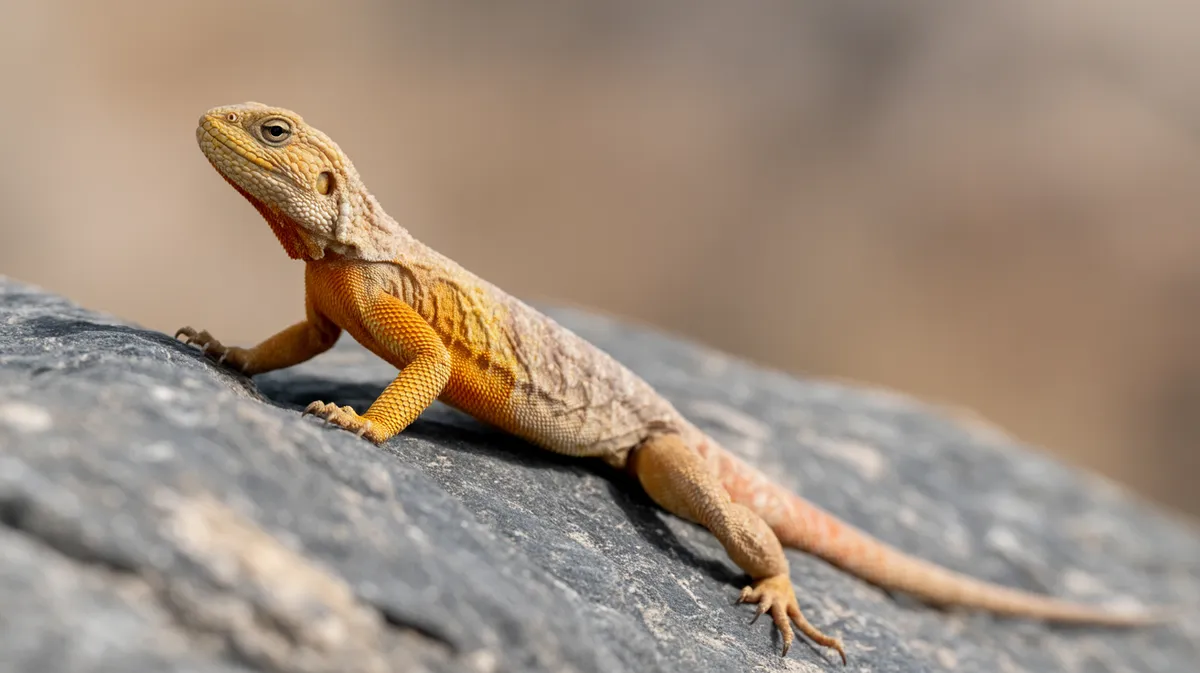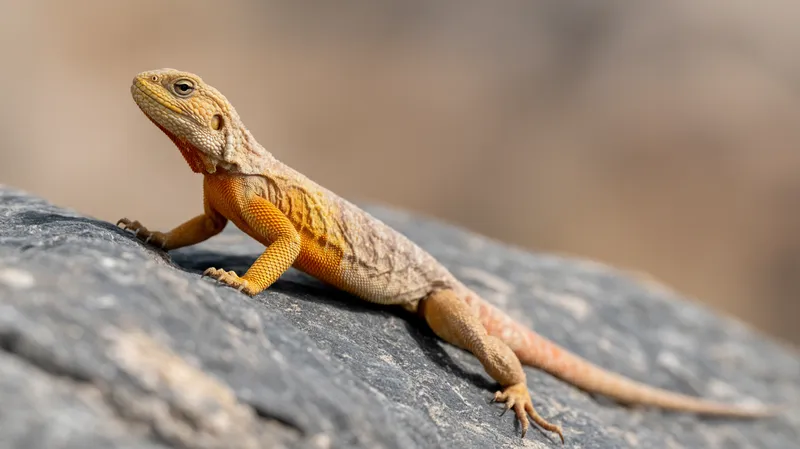
Barbary Coast Agama
Agama bibronii

Meet the Barbary Coast Agama
The Barbary Coast Agama is a robust, medium-sized lizard native to the rocky and arid regions along the northwestern coast of Africa. It displays striking sexual dimorphism, with males often showing vivid blue or reddish hues during the breeding season, while females are generally more subdued in color. This diurnal reptile is well-adapted for climbing and can be seen basking on rocks or walls during the day. Its energetic movements and territorial displays make it a fascinating subject for behavioral observation. The Barbary Coast Agama plays a vital role in its ecosystem by controlling insect populations.
Classification
Reptile
Habitat
Rocky coastal areas, arid scrublands, and urban environments
Diet
Insectivore
Lifespan
5-8 years
Conservation
Least Concern
Weight
25-40 grams
📖Fascinating Facts
Colorful Displays
Males develop bright blue or reddish colors during the breeding season to attract females and intimidate rivals.
Urban Survivors
Barbary Coast Agamas have successfully adapted to city life, frequently seen basking on walls, rooftops, and even garden fences.
Sun Seekers
They are diurnal, spending much of their day basking in the sun to regulate their body temperature.
📋Detailed Description
The Barbary Coast Agama (Agama bibronii) is a medium-sized lizard, typically reaching a snout-to-vent length of 15–20 cm, with males generally larger and more robust than females. Its body is laterally compressed, aiding in maneuvering through rocky crevices, and it possesses strong, clawed limbs adapted for climbing. The head is broad and angular, with prominent orbital ridges and a slightly pointed snout. Males exhibit striking coloration during the breeding season, with vivid blue, orange, or red patches on the head, throat, and flanks, while females and juveniles are more cryptically patterned in earthy browns and grays. The tail is long and muscular, often used for balance and rapid directional changes during escape or territorial displays. Scales are keeled and granular, providing protection against abrasion from rocky substrates. Diurnal and highly alert, A. bibronii is often observed basking in open sunlight to regulate its body temperature. Its keen vision and rapid reflexes make it an effective insect predator, and it displays a repertoire of visual signals, including head-bobbing and push-up displays, to communicate with conspecifics. Social structure is loosely organized, with dominant males defending territories that overlap with the home ranges of several females.
💡 Did you know?
Despite their name, Barbary Coast Agamas can thrive in highly urbanized environments and are frequently spotted on buildings and garden walls.
🔬Research & Sources
🎭Behavior & Social Structure
Barbary Coast Agamas are primarily solitary, with males establishing and vigorously defending territories through visual displays and occasional physical confrontations. These lizards are most active during the warmer hours of the day, emerging shortly after sunrise to bask and forage. Their diet consists mainly of ants, beetles, grasshoppers, and other arthropods, which they capture using rapid, darting movements and precise tongue strikes. Agamas rely heavily on visual cues for both hunting and social interactions, employing a complex array of gestures—such as head-bobbing, tail waving, and body inflation—to signal dominance, submission, or readiness to mate. When threatened, they may retreat into crevices or employ caudal autotomy (tail shedding) as a last resort. Juveniles are more secretive, often remaining close to cover to avoid predation. In urban environments, they have adapted to exploit human structures for basking and shelter, and may be observed foraging near refuse where insect prey is abundant.
👶Reproduction & Life Cycle
Breeding in Agama bibronii typically occurs in spring and early summer, coinciding with increased temperatures and insect availability. Males intensify their coloration and perform elaborate courtship displays to attract females, including rapid head-bobs and lateral body flattening. After successful copulation, females lay clutches of 4–10 leathery eggs in shallow nests excavated in sandy or loose soil, often under rocks or vegetation for protection. Incubation lasts approximately 6–8 weeks, depending on ambient temperature and humidity. Hatchlings emerge fully independent, measuring about 5–7 cm in length, and receive no parental care. Sexual maturity is generally reached within 1–2 years, with growth rates influenced by food availability and environmental conditions. Multiple clutches may be produced in a single season if conditions are favorable.
🛡️Adaptations & Survival
Agama bibronii exhibits a suite of adaptations for life in arid, rocky habitats. Its cryptic coloration provides camouflage against predators, while the ability to rapidly change body color enhances social signaling and thermoregulation. The robust, keeled scales protect against abrasive surfaces and minimize water loss. Behavioral thermoregulation—basking in the sun and retreating to shade or crevices—enables precise control of body temperature in fluctuating environments. The long, muscular tail aids in balance and quick escapes, and the species' acute vision is essential for detecting both prey and predators. In urban areas, behavioral plasticity allows them to exploit new microhabitats and food sources, demonstrating remarkable ecological flexibility.
📚Research Sources
🎨Cultural Significance
While not a major figure in local folklore, the Barbary Coast Agama is occasionally referenced in North African proverbs and children's stories as a symbol of agility and alertness. In some regions, agamas are considered beneficial for their role in controlling pest insects and are tolerated or even encouraged around homes and gardens. There is no significant evidence of traditional medicinal or culinary use, and the species is not targeted by the pet trade to the extent of other agamids.
🔬Recent Research & Discoveries
Recent studies have focused on the species' urban ecology, documenting its successful colonization of anthropogenic habitats and the behavioral adjustments involved. Genetic analyses have clarified its phylogenetic relationships within the Agama genus, supporting its distinction from closely related taxa. Ongoing research is examining the impact of environmental pollutants on reproductive success and the potential for microevolutionary changes in urban populations. Behavioral ecologists have also investigated the role of coloration in social signaling and mate selection, revealing complex interactions between environmental factors and sexual selection.
🎥Wildlife Videos

African collared dove in the world | With Pak Nature Birds |
African collared dove in the world | With Pak Nature Birds | african collared dove,collared dove,african collared doves,african ...
Pak Nature Birds

Animal Atlas Children's Illustrated || World Animals Fishs Birds & Mammals
Animal Atlas Children's Illustrated || World Animals Fishs Birds & Mammals #school #animals #birds #fish #history #mammals ...
Ali Stationery

plant adaptation part 2 ( ( mangrove plant , water lily , palm tree, pine tree, Barbary fig plant))
plant adaptation part 2 we will know that the plants differ in structure and shape of their roots , stems and leaves to adapt the ...
اتعلم و استمتع🔬 Grade4 & Grade5 _science
🌍Habitat Information
The Barbary Coast Agama typically inhabits Rocky coastal areas, arid scrublands, and urban environments environments. Barbary Coast Agamas have adapted to their environments with specialized features and behaviors.
Primary Habitat:
Rocky coastal areas, arid scrublands, and urban environments
More detailed habitat information will be available soon.
🛡️Conservation Status
The Barbary Coast Agama is currently classified as Least Concern. Conservation efforts are crucial for preserving this species for future generations.
Common Threats:
- 🏠Habitat loss and fragmentation
- 🌡️Climate change impacts
- 🎯Hunting and poaching
- 🏭Human-wildlife conflict
⚠️Threats & Conservation Challenges
Currently assessed as Least Concern by the IUCN, the Barbary Coast Agama faces localized threats from habitat degradation, urban expansion, and pollution. While populations remain stable across much of its range, intensive development along the North African coast and increased pesticide use may impact prey availability and nesting sites. Road mortality and predation by domestic animals pose additional risks in urbanized areas. Climate change, with its potential to alter temperature and precipitation patterns, could affect reproductive timing and habitat suitability in the future. Despite these challenges, the species' adaptability to disturbed habitats has so far mitigated significant declines.
🔬Scientific Classification
Scientific Name
Agama bibronii
Classification Hierarchy
🔍 About Taxonomic Classification
Taxonomic classification is a hierarchical system used by scientists to classify and organize living organisms based on shared characteristics and evolutionary relationships.
The system moves from broad categories (Kingdom) to increasingly specific ones, with each animal's scientific name typically consisting of its Genus and species.
📝Community Notes
Share your observations and insights about the Barbary Coast Agama with our community of wildlife enthusiasts.
Join Our Community
Sign in to share your observations and connect with fellow wildlife enthusiasts.
Sign In to ContributeNo community notes yet
Be the first to share your observations about the Barbary Coast Agama!
Explore Barbary Coast Agama
Select a tab above to learn more about this amazing animal.
📸Photo Gallery
No photos available for this animal yet.
🌟Discover More Wildlife
Continue your journey of discovery with more fascinating animals from our database
